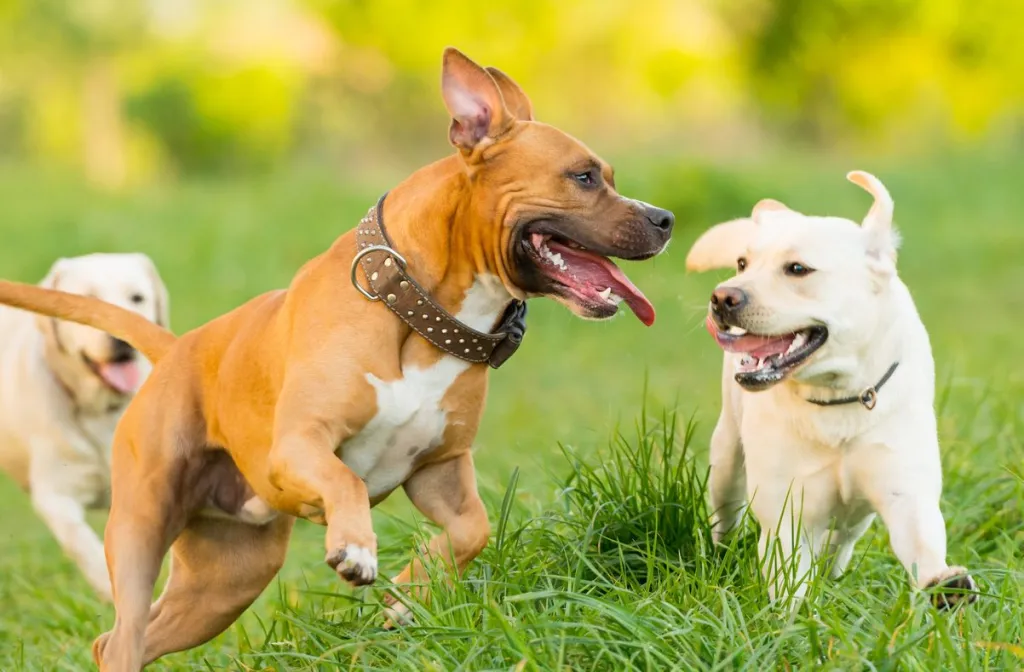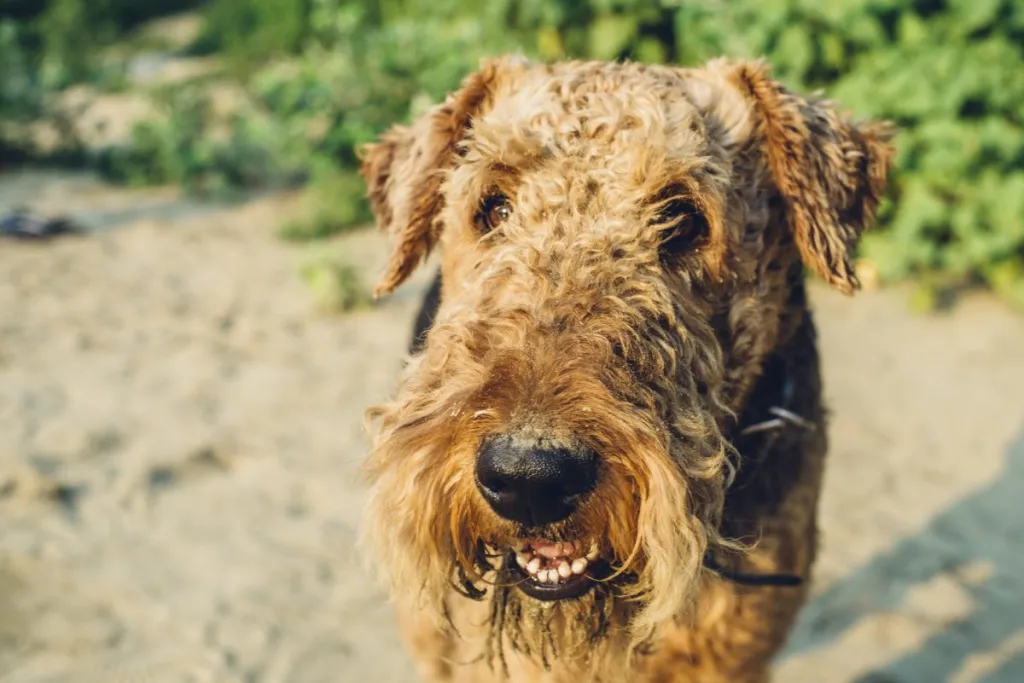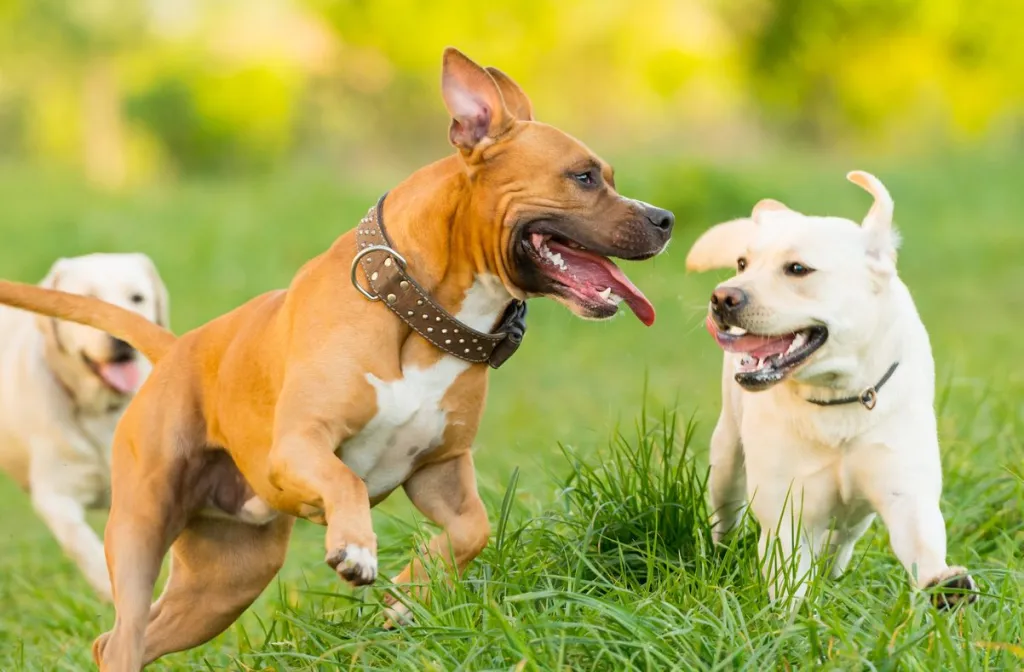
Boxer
Square-jawed and muscular, the Boxer is the George Clooney of the dog world–a looker with a sense of humor and an underlying sweetness. Medium to large in size, the Boxer is known for its muscular and athletic build. With a distinctive square-shaped head, strong jaws, and a short, shiny coat, Boxers exude an air of alertness and strength. Highly regarded for their intelligence, loyalty, and playful nature, Boxers make excellent companions as family pets and working dogs.
Boxers originated in Germany in the 19th century. Historians believe that this breed descended from the now-extinct Bullenbeisser, which hunters used for hunting large game like boar and deer. They developed the modern Boxer by crossing the Bullenbeisser with various other breeds, including the English Bulldog and the Mastiff. These friendly dogs exude playfulness, and an energetic personality. They are affectionate and loyal to their families, often forming strong bonds with their human companions. Despite their strong and athletic appearance, they are gentle and patient with children, making them excellent family dogs. Boxers also earn a reputation for being protective of their loved ones, making them excellent watchdogs.
Reading: Boxer
When considering a Boxer, it’s advisable to prioritize adopting from rescue organizations or shelters to provide a loving home to a dog in need. However, if you’re on the search for Boxer puppies and decide to purchase, it’s crucial to choose a reputable breeder. Conduct thorough research to ensure that the breeder follows ethical practices and prioritizes the well-being of their dogs. Reputable Boxer breeders prioritize the health and temperament of their dogs, conduct necessary health screenings, and provide a nurturing environment for the puppies. This active approach ensures that you bring home a healthy and happy pup while discouraging unethical breeding practices.
Quick Facts
- Origin: Germany
- Size: Male: 23-25 inches (58-63 cm) at the shoulder, Female: 21-23 inches (53-58 cm) at the shoulder
- Weight: Male: 60-70 pounds (27-32 kg), Female: 50-60 pounds (23-27 kg)
- Breed group: Working
- Lifespan: 10-12 years
- Coat: Short, smooth
- Temperament: Friendly, playful, loyal, intelligent
- Exercise needs: 30-60 minutes of exercise per day
- Training: Easy to train with positive reinforcement
- Grooming: Weekly brushing
- Health: Some health problems that are common in the Boxer include hip dysplasia, elbow dysplasia, cancer, and heart disease.
- A Boxer appears as one of the dogs in “Good Boy!“, a 2003 American science fiction comedy film starring Molly Shannon and Matthew Broderick.
- Notable Boxer owners include celebrities such as Tony Curtis, Justin Timberlake, Gisele Bundchen, Jessica Biel, Cameron Diaz, and Ryan Reynolds, to name a few.
Boxer Pictures
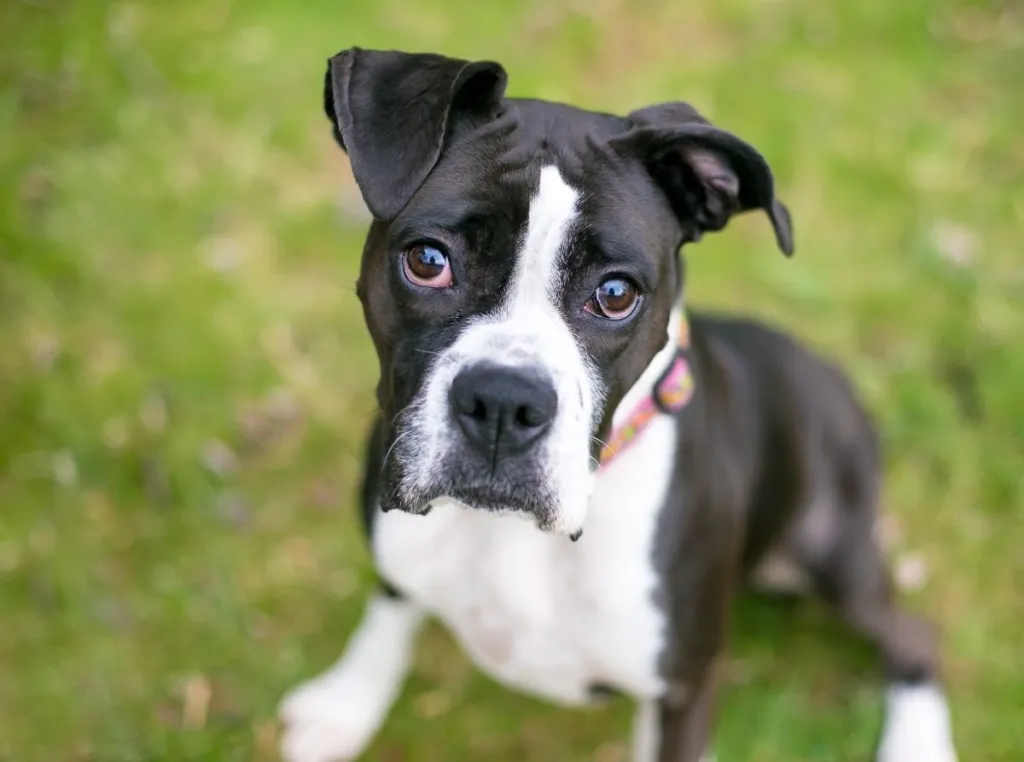

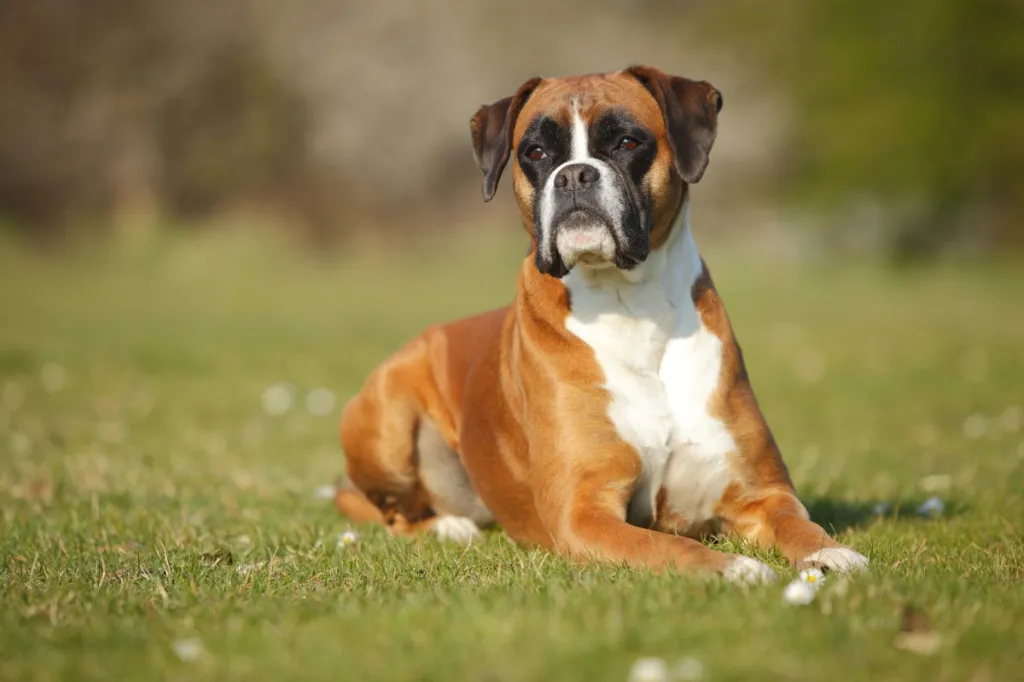
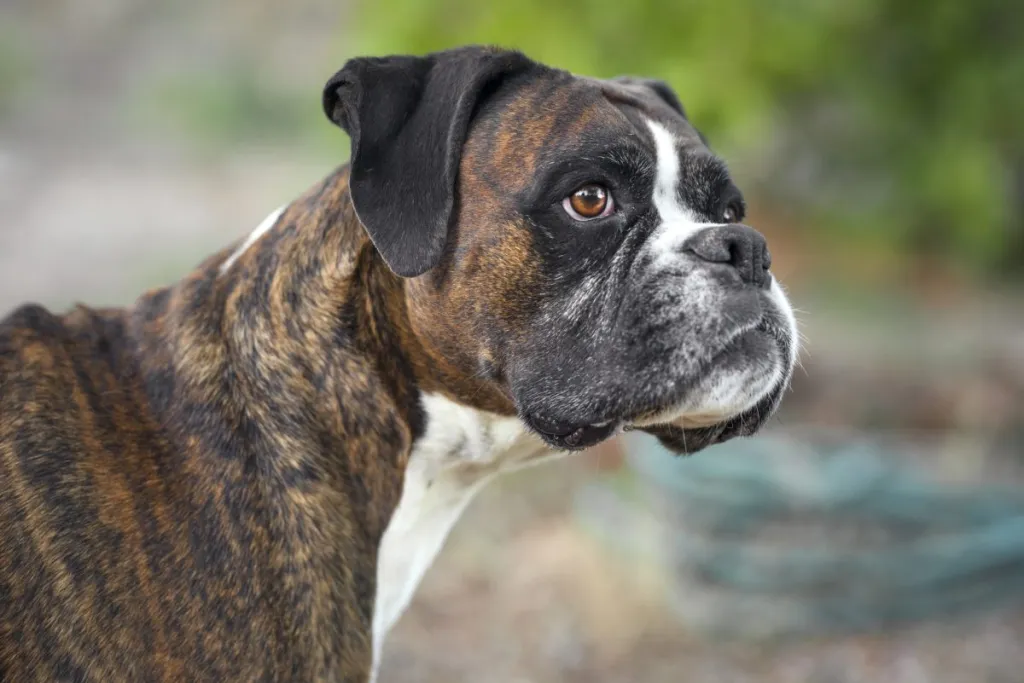
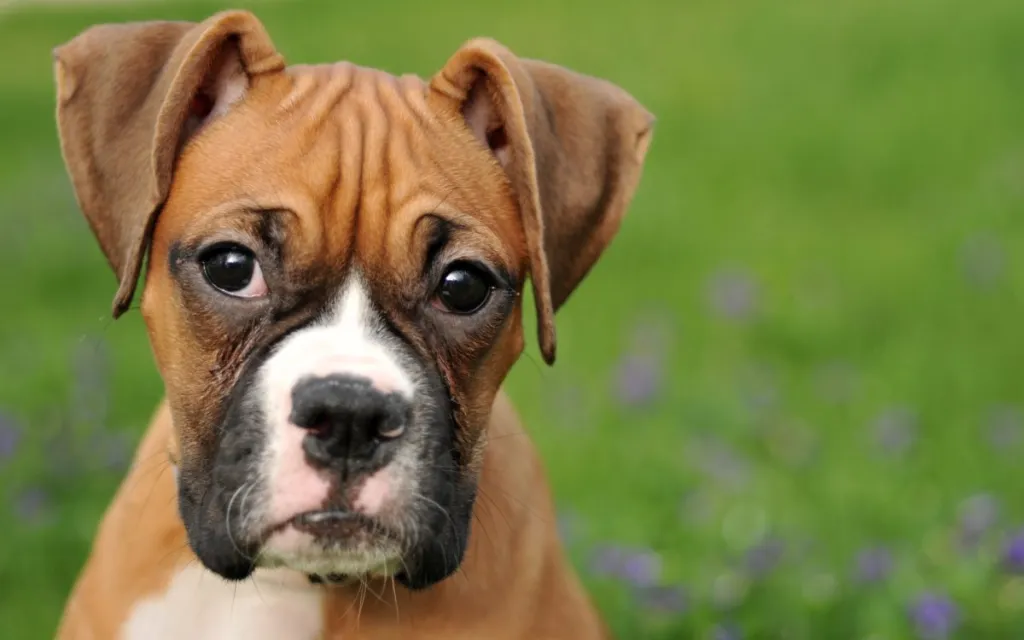
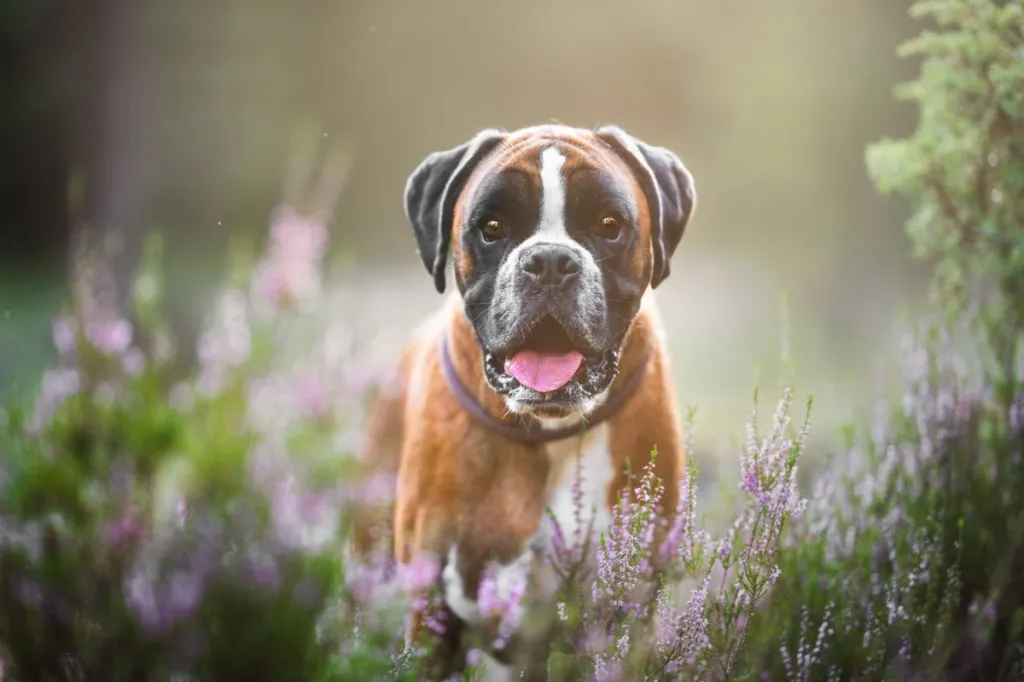
Adaptability
-
Adapts Well To Apartment Living
Looking for the best dog for your apartment? Contrary to popular belief, the suitability of dogs who adapt well to apartment living goes beyond its size. Apartment dwellers have a myriad of dog breeds to choose from as potential companions, with various factors to consider. Some large breeds can adapt well to apartment living and have lower activity levels. Others may require more space and possess higher energy levels. On the other hand, certain small dog breeds with abundant energy can still find contentment with indoor playtime or brisk walks.
However, when selecting a dog that adapts well apartments, it is essential to prioritize your neighbors. Opting for a pet that doesn’t excessively bark and behaves politely when encountering others in shared spaces like is crucial for maintaining a harmonious apartment environment.
In high-rise settings, it’s worth noting that numerous small dogs may exhibit a propensity for high energy and frequent barking. This makes them less suitable for apartment living. Therefore, desirable qualities in an apartment dog encompass being quiet, low-energy, and displaying polite behavior towards other residents.
Factors To Consider When Choosing A Dog For An Apartment
When considering dogs that adapt well to apartments, size alone should not be the sole determinant. Apartment dwellers have a wealth of dog breeds to choose from as potential furry companions. It’s important to remember that the size of your living space is just one factor to consider. While some larger breeds can adapt well to apartment living, with lower, others may require more space and have higher energy levels, making them less suitable for smaller apartments. Conversely, certain small dog breeds with higher energy levels can still thrive in apartments, finding contentment through indoor playtime or brisk walks. However, it is crucial to consider your neighbors’ comfort when selecting a dog. Opt for a pet that doesn’t bark excessively and behaves politely when interacting with others in shared spaces.
Therefore, it’s important to prioritize qualities such as being quiet, low-energy, calm indoors, and exhibiting good manners when living in close proximity to other residents. By considering these factors, you can find a dog that will adapt well to apartment living and create a harmonious living environment for everyone involved.
- Dogs Not Well Suited to Apartment Living
Click here for more information on this characteristic
-
Good For Novice Owners
Some dogs are simply easier than others; they take to training better and are fairly easygoing. They’re also resilient enough to bounce back from your mistakes or inconsistencies.
Dogs who are highly sensitive, independent thinking, or assertive may be harder for a first-time dog parent to manage. You’ll get your best match if you take your dog-owning experience into account as you choose your new pooch.
If you’re new to dog parenting, take a look at 101 Dog Tricks and read up on how to train your dog!
- See Dogs Who Are Good For Experienced Owners
Click here for more information on this characteristic
-
Sensitivity Level
Some dogs will let a stern reprimand roll off their backs, while others take even a dirty look to heart. Low-sensitivity dogs, also called “easygoing,” “tolerant,” “resilient,” and even “thick-skinned,” can better handle a noisy, chaotic household, a louder or more assertive owner, and an inconsistent or variable routine. Do you have young kids, throw lots of dinner parties, play in a garage band, or lead a hectic life? Go with a low-sensitivity dog.
- See Dogs Who Have Low Sensitivity Levels
Click here for more information on this characteristic
-
Tolerates Being Alone
Some breeds bond very closely with their family and are more prone to worry or even panic when left alone by their owner. An anxious dog can be very destructive–barking, whining, chewing, and otherwise causing mayhem. These breeds do best when a family member is home during the day or if you can take the dog to work.
- See Dogs Poorly Suited To Be Alone
Click here for more information on this characteristic
-
Tolerates Cold Weather
Breeds with very short coats and little or no undercoat or body fat, such as Greyhounds, are vulnerable to the cold. Dogs with a low cold tolerance need to live inside in cool climates and should have a jacket or sweater for chilly walks. You can find a great jacket for your dog here!
- Click here to see Dogs Poorly Suited For Cold Weather
Click here for more information on this characteristic
-
Tolerates Hot Weather
Dogs with thick, double coats are more vulnerable to overheating. So are breeds with short noses, like Bulldogs or Pugs, since they can’t pant as well to cool themselves off. If you want a heat-sensitive breed, your dog will need to stay indoors with you on warm or humid days, and you’ll need to be extra cautious about exercising your dog in the heat.
- See Dogs Poorly Suited For Hot Weather
Click here for more information on this characteristic
All-around friendliness
-
Affectionate With Family
When it comes to unconditional love and unwavering loyalty, few animals can rival the affectionate nature of dogs. These remarkable creatures have earned their reputation as man’s best friend, and it’s no wonder! Many breeds are particularly renowned for their love and devotion to their families. With their warm hearts and wagging tails, affectionate family dogs enrich the lives of their owners in countless ways.
While we like to think that all dogs are creatures of love, some breeds may be more outwardly affectionate than others. Some of this is due to temperament, breed group, and purpose. For example, dogs first bred for working or guarding independently of their human companions may show less affection than dogs specifically bred to be companion animals. Of course, this is no indication of the bond between a human and pup, but rather related to temperament and breed origin.
Affection may be demonstrated through a myriad of heartwarming behaviors. This may including tail-wagging greetings, cuddles on the couch, and an ever-present eagerness to be by their family’s side. This devotion extends to both adults and children, making dogs wonderful additions to family households. The warmth of a dog’s affection not only provides emotional support but also creates an environment of joy and connection within the family, fostering a sense of togetherness.
How To Know If A Dog Is Good With Families
The affectionate nature of family dogs extends beyond play and cuddles. Dogs have a remarkable ability to sense their owner’s emotions, offering comfort and support during difficult times. Whether it’s a wagging tail after a long day at work or a sympathetic nuzzle during moments of sadness, they prove time and again that they are attuned to their family’s needs.
It is important to note that not all dogs of the same breed will be equally affectionate. Some dogs may be more independent or aloof, while others may be more clingy or demanding of attention. The best way to find out how affectionate a dog is is to meet them in person and interact with them.
See Dogs Less Affectionate with Family
Click here for more information on this characteristic
-
Kid-Friendly
Being gentle with children, sturdy enough to handle the heavy-handed pets and hugs they can dish out, and having a blasé attitude toward running, screaming children are all traits that make a kid-friendly dog. You may be surprised by who’s on that list: Fierce-looking Boxers are considered good with children, as are American Staffordshire Terriers (which are considered Pit Bulls). Small, delicate, and potentially snappy dogs such as Chihuahuas aren’t always so family-friendly.
- See Dogs Who Are Not Kid Friendly
**All dogs are individuals. Our ratings are generalizations, and they’re not a guarantee of how any breed or individual dog will behave. Dogs from any breed can be good with children based on their past experiences, training on how to get along with kids, and personality. No matter what the breed or breed type, all dogs have strong jaws, sharp pointy teeth, and may bite in stressful circumstances. Young children and dogs of any breed should always be supervised by an adult and never left alone together, period.
Click here for more information on this characteristic
-
Dog Friendly
Friendliness toward dogs and friendliness toward humans are two completely different things. Some dogs may intimidate other dogs, even if they’re love-bugs with people; others are naturally more dog friend and would rather play than fight. It’s important to note that breed isn’t the only factor when it comes to how dog-friendly your pup will be. Sure, some dogs breeds first bred for working independently may not immediately gravitate towards other dogs, but early socialization plays a lot more into how dogs will interact than their origin. Dogs who lived with their littermates and mother until at least six to eight weeks of age or who spent lots of time playing with other dogs during puppyhood are more likely to have good canine social skills.
Still, some dog-friendly breeds are more pack-oriented and naturally thrive with other dogs. Dogs with this trait typically exhibit an innate ability to get along well with other pups. Dogs with this trait may be more eager to greet new dogs, display more social behavior at places like dog parks, or more confidently allow intimate sniffs from their canine acquaintances. This quality extends beyond mere tolerance and often manifests as a genuine enjoyment of the company of fellow canines, making these dogs ideal companions for those looking to build a multi-dog household. Additionally, they’ll pair well with pet parents hoping to take their pooch on social adventures, such as going to dog park or hanging out on dog-friendly patios.
Raising a dog-friendly dog
(Photo Credit: Stefan Cristian Cioata | Getty Images) While some dog breeds are more naturally inclined to make friends with other dogs, you may choose a puppy or adult dog that needs a little help. It’s may be common knowledge that there is a small window during a puppy’s early development when they are the most adaptable in terms of how they’ll interact with other dogs. You may, however, bring home an adult dog or a rescue and not get the opportunity. Not to fear! There are still many ways to help your pooch become dog-friendly.
Socialization is always the best way to ensure your dog becomes their most friendly self. You can help by exposing your pooch to as many sights, sounds, and environments as possible. Set up doggy playdates, enroll in dog training classes, or visit the dog park. Of course, be sure to do your research on dog training methods to ensure your dog will listen to you in social settings. Confidence is key!
- See Dogs Who Are Not So Dog Friendly
Click here for more information on this characteristic
-
Friendly Toward Strangers
Stranger-friendly dogs will greet guests with wagging tails and nuzzles; others are shy, indifferent, or even aggressive. However, no matter what the breed, a dog who was socialized and exposed to lots of different types, ages, sizes, and shapes of people as a puppy will respond better to strangers as an adult. Remember that even friendly dogs should stay on a good, strong leash like this one in public!
- See Dogs Who Are Less Friendly To Strangers
Click here for more information on this characteristic
Health And Grooming Needs
-
Amount Of Shedding
When considering adding a pup into your home, you may want to consider the amount of shedding your furry companion will experience. Regardless of the dog breed, you will want to be prepared for at least some amount of pet hair on your clothing and around your house. Of course, this amount can vary greatly as shedding tendencies differ significantly among breeds. Some dogs shed continuously, especially dog breeds with heavy double-coats or long fur. Others undergo seasonal “blowouts” and some hardly shed at all.
Having a set of grooming tools at your disposal is essential for tending to your dog’s coat. Deshedding tools are excellent for eliminating excess hair that can become trapped in your dog’s fur. There are also brushes designed to gently remove dead hair without causing discomfort to your dog’s skin. Grooming gloves and bathing brushes can aid in loosening dead hair during shampooing, making it easier to brush away. Clippers and a detangling spray effectively tackle matted fur. Additionally, home tools for managing pet hair on fabric and furniture can make a big difference. Pet tape rollers, fur brooms, and specialized vacuums can eliminate pet hair from carpet, clothing, and even furniture.
If you’re someone who values a spotless environment, you might want to opt for a low-shedding breed. Otherwise, equip yourself with the right tools to fight the fur. Concerns about shedding shouldn’t prevent you from relishing your time at home with your dog. Establishing a consistent grooming regimen can significantly minimize the presence of loose hair in your living space and on your clothing. For additional guidance on managing dog shedding, explore our recommendations for addressing excessive shedding and designing your home with your pet (and their shedding tendencies) in mind.
Related:
Read more : Havanese
How to Effectively Deal with Dog Shedding
4 Best Dog Brushes
Click here for more information on this characteristic
-
Drooling Potential
Drool-prone dogs may drape ropes of slobber on your arm and leave big, wet spots on your clothes when they come over to say hello. If you’ve got a laid-back attitude toward slobber, fine; but if you’re a neatnik, you may want to choose a dog who rates low in the drool department.
- See Dogs Who Are Not Big Droolers
Click here for more information on this characteristic
-
Easy To Groom
Some breeds are brush-and-go dogs; others require regular bathing, clipping, and other grooming just to stay clean and healthy. Consider whether you have the time and patience for a dog who needs a lot of grooming, or the money to pay someone else to do it.
- See Dogs Who Require More Grooming
Click here for more information on this characteristic
-
General Health
Due to poor breeding practices, some breeds are prone to certain genetic health problems, such as hip dysplasia. This doesn’t mean that every dog of that breed will develop those diseases; it just means that they’re at an increased risk.
If you’re adopting a puppy, it’s a good idea to find out which genetic illnesses are common to the breed you’re interested in. You may also want to ask if your shelter or rescue has information about the physical health of your potential pup’s parents and other relatives.
- See Dogs More Prone To Health Problems
Click here for more information on this characteristic
-
Potential For Weight Gain
Some breeds have hearty appetites and tend to put on weight easily. As in humans, being overweight can cause health problems in dogs. If you pick a breed that’s prone to packing on pounds, you’ll need to limit treats, make sure they get enough exercise, and measure out their daily food servings into regular meals rather than leaving food out all the time.
Ask your vet about your dog’s diet and what they recommend for feeding your pooch to keep them at a healthy weight. Weight gain can lead to other health issues or worsen problems like arthritis.
Click here for more information on this characteristic
-
Size
Get ready to meet the giants of the doggy world! Large dog breeds aren’t just big balls of fluff, they’re like loving, oversized teddy bears on a mission to steal your heart. Need some convincing? Let’s dive into the awesome benefits of owning one!
First things first, these pooches are a living security system! With their impressive size and thunderous barks, they’ll have any would-be intruder running for the hills. Talk about peace of mind! Plus, who needs an alarm when you’ve got a furry giant protecting your castle?
But that’s not all. Large dog breeds are all about loyalty and devotion. They’ll stick by your side through thick and thin, becoming your most dedicated bestie. Their love knows no bounds! When you have a giant fluffball showing you unconditional love, you’ll feel like the luckiest human on the planet.
Now, let’s talk about their talents. These big fellas are the ultimate working partners. With brains and brawn, they’re up for any challenge. From search and rescue missions to lending a helping paw to those in need, these dogs are superheroes in fur coats. They’ll make you proud every step of the way!
Don’t let their size fool you—these gentle giants have hearts as big as their paws. They’re incredible with kids and other pets, spreading their love like confetti. Their patience and kindness make them perfect family pets, ensuring harmony in your household.
Oh, and get ready to break a sweat! These dogs are fitness enthusiasts, and they’ll keep you on your toes. Daily walks, jogs, and play sessions will not only keep them happy and healthy but will also give you a reason to ditch the couch and join in on the fun. It’s a win-win situation!
So, if you’re ready for a dose of big love, go ahead and consider a large dog breed. They’re the best wing-dog you could ever ask for, ready to make your life a thousand times more exciting, loving, and downright awesome! Get ready for the big adventure of a lifetime!
- Medium-Sized Dogs
- Small Dogs
Click here for more information on this characteristic
Trainability
-
Easy To Train
Easy-to-train dogs are more adept at forming an association between a prompt (such as the word “sit”), an action (sitting), and a consequence (getting a treat) very quickly. Other dogs need more time, patience, and repetition during training.
Many breeds are intelligent but approach training with a “What’s in it for me?” attitude, in which case you’ll need to use rewards and games to teach them to want to comply with your requests.
Related:
10 Fun, Impressive Tricks You Can Teach Any Dog
Dogs Who Are Challenging To Train
Click here for more information on this characteristic
-
Intelligence
Dogs who were bred for jobs that require decision making, intelligence, and concentration, such as herding livestock, need to exercise their brains, just as dogs who were bred to run all day need to exercise their bodies. If they don’t get the mental stimulation they need, they’ll make their own work–usually with projects you won’t like, such as digging and chewing. Obedience training and interactive dog toys are good ways to give a dog a brain workout, as are dog sports and careers, such as agility and search and rescue.
- See Dogs Who Have Lower Intelligence
Click here for more information on this characteristic
-
Potential For Mouthiness
Common in most breeds during puppyhood and in Retriever breeds at all ages, mouthiness means a tendency to nip, chew, and play-bite (a soft, fairly painless bite that doesn’t puncture the skin). Mouthy dogs are more likely to use their mouths to hold or “herd” their human family members, and they need training to learn that it’s fine to gnaw on chew toys, but not on people. Mouthy breeds tend to really enjoy a game of fetch, as well as a good chew on a toy that’s been stuffed with kibble and treats.
Click here for more information on this characteristic
-
Prey Drive
Dogs with a high prey drive have an instinctive desire to stalk, capture, and prey upon potential food sources. Dogs who were bred to hunt, such as Terriers, have an inborn desire to chase — and sometimes kill — other animals. Anything whizzing by — such as cats, squirrels, and perhaps even cars — can trigger that instinct.
How to address a high prey drive
Off-leash adventures are too great a temptation for pups who will wander and hunt. Dogs who like to chase need to be leashed. And, even on a leash, you may experience your dog pulling on the leash to reach rodents or birds in their sight. Otherwise, these pups should be kept in a fenced area when outdoors. If your pup has a high prey drive, you’ll need a high, secure fence in your yard.
These breeds generally aren’t a good fit for homes with smaller pets that can look like prey, such as cats, hamsters, or small dogs. Breeds that were originally used for bird hunting, on the other hand, generally won’t chase, but you’ll probably have a hard time getting their attention when there are birds flying by.
Other behavioral concerns
Observing your dog’s prey drive, which is instinctual and biologically-rooted, is not the same as observing aggression. Much aggression is born of fear and anxiety, especially in the case of dog aggression toward humans.
The tendency to wander, even into oncoming traffic, can produce diasterious results for pups with predatory instincts. It can also lead to pups being bitten by snakes or attacked by other wild animals they may pursue while on the hunt.
- See Dogs Who Have Low Prey Drive
Click here for more information on this characteristic
-
Tendency To Bark Or Howl
Some breeds sound off more often than others. When choosing a breed, think about how often the dog vocalizes. Learn more about breeds with a tendency to bark or howl.
If you’re considering a hound, would you find their trademark howls musical or maddening? If you’re considering a watchdog, will a city full of suspicious “strangers” put your pup on permanent alert? Will the local wildlife literally drive your dog wild? Do you live in housing with noise restrictions? Do you have neighbors nearby? Then you may wish to choose a quieter dog.
- See Dogs Who Are Mostly Quiet
Click here for more information on this characteristic
-
Wanderlust Potential
Some breeds are more free-spirited than others. Nordic dogs such as Siberian Huskies were bred to range long distances, and given the chance, they’ll take off after anything that catches their interest. And many hounds simply must follow their noses–or that bunny that just ran across the path–even if it means leaving you behind.
- See Dogs Less Prone To Wander
Click here for more information on this characteristic
Exercise needs
-
Energy Level
High-energy dogs are always ready and waiting for action. Originally bred to perform a canine job of some sort, such as retrieving game for hunters or herding livestock, they have the stamina to put in a full workday. They need a significant amount of exercise and mental stimulation, and they’re more likely to spend time jumping, playing, and investigating any new sights and smells.
Read more : Whippet
Low-energy dogs are the canine equivalent of a couch potato, content to doze the day away. When picking a breed, consider your own activity level and lifestyle, and think about whether you’ll find a frisky, energetic dog invigorating or annoying.
- See Dogs Who Have Low Energy
Click here for more information on this characteristic
-
Intensity
A vigorous dog may or may not have high energy, but everything they do, they do with vigor: they strain on the leash (until you train them not to), try to plow through obstacles, and even eats and drinks with great big gulps. These dynamos need lots of training to learn good manners, and may not be the best fit for a home with young kids or someone who’s elderly or frail. A low-vigor dog, on the other hand, has a more subdued approach to life.
- See Dogs With Low Intensity
Click here for more information on this characteristic
-
Exercise Needs
Some breeds do fine with a slow evening stroll around the block. Others need daily, vigorous exercise, especially those that were originally bred for physically demanding jobs, like herding or hunting.
Without enough exercise, these breeds may put on weight and vent their pent-up energy in ways you don’t like, such as barking, chewing, and digging. Breeds that need a lot of exercise are good for outdoorsy, active people, or those interested in training their dog to compete in a high-energy dog sport, such as agility.
- See Dogs Who Don’t Need Tons of Exercise
Click here for more information on this characteristic
-
Potential For Playfulness
Some dogs are perpetual puppies — always begging for a game — while others are more serious and sedate. Although a playful pup sounds endearing, consider how many games of fetch or tag you want to play each day, and whether you have kids or other dogs who can stand in as playmates for the dog.
- See Dogs Who Are Less Playful
Click here for more information on this characteristic
Boxer Overview
Boxers, large, muscular, square-headed dogs, appear imposing until their mischievous and joyful eyes reveal their true nature. They’re known as the “Peter Pan” of dogs due to their playful, energetic disposition. Boxers reach full maturity at three years, boasting intelligence, alertness, and fearlessness, while remaining friendly. Their loyalty to the family is remarkable, though they can be headstrong when faced with harsh training. With minimal grooming needs, Boxers make excellent family companions, as long as they receive ample physical exercise and mental stimulation. Their origin traces back to Germany, and their short, shiny coats are usually fawn or brindle with white markings. Docked tails and cropped ears are common, but many owners now prefer leaving them natural. Boxers are renowned for their love and loyalty, often trying to be lapdogs. They display high spirits, happiness, and energy, entertaining with playful antics like the “kidney bean” dance and their unique “woo-woo” sound. Their strength and courage make them suitable for military, police, and search-and-rescue work. Proper care includes indoor living due to their sensitivity to extreme temperatures. Boxers aren’t for everyone, but those prepared to provide love, stimulation, and cuddles will find an ideal companion in this breed.
Boxer Highlights
Here are some of the highlights of the Boxer breed:
- Affectionate: Boxers are very affectionate dogs and love to be around their people. They are known for their wagging tails and slobbery kisses.
- Playful: Boxers are also very playful dogs and love to have fun. They are always up for a game of fetch or a good belly rub.
- Intelligent: Boxers are very intelligent dogs and can be easily trained. They are often used as working dogs, such as therapy dogs and search and rescue dogs.
- Trainable: Boxers are also very trainable dogs and can be taught a variety of tricks. They are eager to please their owners and love to learn new things.
- Loyal: Boxers are very loyal dogs and will always protect their family. They are known for their bravery and willingness to stand up to danger.
Boxer History
The Boxer’s ancestors were the German Bullenbeisser, a dog descended from Mastiffs, and the Bulldog. The Bullenbeisser was used as a hunting dog for centuries to hunt bear, wild boar, and deer, tasked with catching and holding the prey until hunters arrived. Over time, Bullenbeissers lost their jobs on estates and began to be used by farmers and butchers to guard and drive cattle.
The Boxer we know today was developed in the late 19th century when a Munich man named Georg Alt bred a brindle-colored female Bullenbeisser named Flora with a local dog of unknown origin. In the litter was a fawn-and-white male that was named Lechner’s Box, believed to be the start of the line that would become the Boxer we know today. Lechner’s Box was bred to his dam, Flora, and one of the litter was a female called Alt’s Schecken, registered as a Bierboxer or Modern Bullenbeiser.
Schecken was then bred to an English Bulldog named Tom to produce a dog named Flocki, who became the first Boxer to be entered in the German Stud Book after winning at a Munich show that had a special event for Boxers. Flocki’s sister, a white female, was even more influential when she was mated with Piccolo von Angertor, a grandson of Lechner’s Box. One of her pups was a white female named Meta von der Passage, considered to be the mother of the Boxer breed, even though photographs of her show that she bore little resemblance to the modern Boxer.
John Wagner, author of The Boxer, first published in 1939, said the following about her: “Meta von der Passage played the most important role of the five original ancestors. Our great line of sires all trace directly back to this female. She was a substantially built, low to the ground, brindle and white parti-color, lacking in underjaw and exceedingly lippy. As a producing bitch few in any breed can match her record. She consistently whelped puppies of marvelous type and rare quality. Those of her offspring sired by Flock St. Salvator and Wotan dominate all present-day.”
In 1894, three Germans named Roberth, Konig, and Hopner decided to stabilize the breed and put it on exhibition at a dog show in Munich in 1895, founding the first Boxer Club the next year. The breed became known in other parts of Europe in the late 1890s. Around 1903, the first Boxers were imported into the U.S. The first Boxer was registered by the American Kennel Club in 1904, a dog named Arnulf Grandenz. In 1915, the American Kennel Club (AKC) recognized the first Boxer champion, Sieger Dampf v Dom, owned by Governor and Mrs. Lehman of New York.
When Word War I broke out, Boxers were enlisted into the military, serving as messenger dogs, carrying packs and acting as attack and guard dogs. Boxers started becoming popular in the U.S. in the 1940s when soldiers coming home from World War II brought their Boxer mascots with them. Through them, the breed was introduced to more people and soon became a favorite companion animal, show dog, and guard dog.
The American Boxer Club (ABC) was formed in 1935 and gained acceptance by the AKC in the same year. In the early days, there was a lot of controversy within the club about the Boxer standard. In 1938, the club finally approved a new standard. The latest revisions of the standard were in 2005. Today, the Boxer ranks 7th among the 155 breeds and varieties registered by the AKC.
Boxer Size
The height at the shoulder for males usually ranges from 22.5 to 25 inches, and they weigh around 70 pounds. Females typically stand 21 to 23.5 inches tall and weigh about 60 pounds.
Boxer Personality
The Boxer is a vigilant “hearing” guard dog, both dignified and self-assured when not being a clown. With children, they’re patient and playful. Strangers are met with wariness, but they respond politely to friendly people. They display aggression only in defense of their family and home. Temperament is influenced by factors like heredity, training, and socialization. Boxer puppies with good temperaments are curious, playful, and open to approaching and being held by people. Socialization, early exposure to diverse experiences, people, and places, is crucial to ensure they grow up as well-rounded, friendly dogs. Enrolling them in puppy kindergarten classes and regular interactions with visitors, neighbors, and various environments help develop their social skills.
Boxer Health
Boxers are generally a healthy breed, but like all dogs, they have certain health conditions to be aware of. Although not all Boxers will experience these diseases, it’s essential to keep them in mind if considering this breed. Here are some conditions to watch out for, along with precautions:
-
Cancer: Boxers are prone to mast cell tumors, lymphoma, and brain tumors. White Boxers with excessive white markings can get sunburned and may develop skin cancer. Apply sunscreen to their ears, nose, and coat when they go outdoors.
-
Aortic stenosis/sub-aortic stenosis (AS/SAS): A common heart defect found in Boxers. It narrows the aorta below the aortic valve, straining the heart’s blood supply. This condition can lead to fainting and sudden death. A veterinary cardiologist can diagnose it after detecting a heart murmur. Affected dogs should not be bred.
-
Boxer cardiomyopathy (BCM): An inherited condition causing an irregular heartbeat due to an electrical conduction disorder. It can result in weakness, collapse, or sudden death. Detection is challenging, leading to unexpected fatalities. Dogs showing signs of this condition should not be bred.
-
Hip Dysplasia: A heritable condition where the thighbone doesn’t fit snugly into the hip joint. While some dogs show signs of pain and lameness, others may not exhibit discomfort. X-ray screening helps detect hip dysplasia, and affected dogs should not be bred.
-
Hypothyroidism: Caused by a deficiency of thyroid hormone, leading to infertility, obesity, mental dullness, and lack of energy. It can be managed with daily thyroid replacement pills.
-
Corneal Dystrophy: Non-inflammatory eye diseases inherited in Boxers, affecting one or more corneal layers, causing opaque areas in the eyes.
-
Demodectic Mange: Also called Demodicosis, it’s caused by mites passed from mother to pups. A weakened immune system can lead to demodectic mange, resulting in localized or generalized skin issues.
-
Gastric dilatation-volvulus (GDV), also called Bloat or Torsion: A life-threatening condition more common in deep-chested dogs like Boxers. Feeding habits and exercise patterns can contribute to GDV. Immediate medical attention is crucial.
-
Allergies: Boxers are prone to both environmental and food-related allergies. Itchy, scaly skin should be examined by a vet.
-
Deafness: White Boxers are especially susceptible, with about 20% being deaf. Responsible breeding is essential to reduce the risk of deafness.
Regular vet check-ups and early detection are vital for maintaining Boxers’ health and well-being.
Boxer Care
Boxers are indoor dogs due to their short noses and coats, making them unsuitable for outdoor living. However, they enjoy playing in a fenced yard. Engage them in play or walk them twice daily for at least half an hour to keep their muscles toned and their energy satisfied. Activities like fetch, long walks, or dog sports like agility and flyball are great options. Adequate exercise ensures good behavior—a tired Boxer is a well-behaved Boxer.
Training is crucial for Boxers, as their size and strength can inadvertently harm people. Their temperament, being happy and excitable, requires early and consistent training using firm, fair methods with positive reinforcement through praise, play, and food rewards. Be consistent to avoid pushing boundaries. Settle them down before training class with a walk or play session for better focus.
Housetraining requires patience; some Boxers are trained by four months, while others take longer. Regular potty breaks and praising them outdoors are essential. Crate training is recommended for their successful training.
Boxer Feeding
For an ideal Boxer diet, choose high-quality food suited for medium-sized breeds with high energy. Optimize their chances for a long, healthy life by providing proper nutrition. To prevent weight gain, adhere to a regular feeding schedule with two meals per day. Limit treats and avoid leaving food out all day. Follow your veterinarian’s guidelines for a healthy diet, as Boxers’ dietary needs change from puppyhood to adulthood and into their senior years. Consult your vet for personalized recommendations based on factors like weight, energy levels, and overall health.
Boxer Coat Color And Grooming
Boxers boast a sleek, short coat with tight skin, accentuating their athletic bodies. They come in fawn or brindle colors, occasionally with white markings. Fawn ranges from light tan to mahogany, while brindle displays striking black stripes on a fawn background. White markings should not cover more than one-third of the coat, and excessive white is discouraged due to potential health issues like skin cancer and deafness.
The Boxer’s face features a black mask, sometimes with a white stripe between the eyes known as a blaze. They lack the gene for a solid black coat, so black Boxers are not seen. In the UK, richly colored fawn Boxers are referred to as “red.” Although white Boxers cannot be shown in conformation or bred, they still possess the wonderful Boxer personality that makes them excellent companions. Regular grooming of the Boxer’s coat is minimal, with weekly brushing sufficient to control shedding. Bathing should be done as needed.
Maintaining dental hygiene and nail care are essential. Regularly brushing their teeth prevents periodontal disease, and trimming nails every few weeks keeps their feet in good condition. Starting grooming routines early in puppyhood helps them become accustomed to the process, ensuring positive veterinary exams and handling as adults. Regular grooming also provides an opportunity to check for any potential health issues, such as sores, rashes, or signs of infection, promoting early detection and care.
Boxer Children And Other Pets
Boxers are fond of kids and make excellent playmates for active older children. However, their rambunctious nature may be too much for toddlers, possibly causing accidental knocks during play. It’s crucial to educate children on approaching and interacting with dogs safely, supervising all interactions to avoid any unwanted incidents like biting or pulling ears or tails. Teach your child never to disturb a dog while eating or sleeping, and not to try taking away the dog’s food. Never leave a dog unsupervised with a child. With proper socialization, Boxers can also get along well with other dogs and cats, particularly if raised together.
Boxer Rescue Groups
Boxers are often purchased without any clear understanding of what goes into owning one. There are many Boxers in need of adoption and or fostering. There are a number of rescues that we have not listed. Many can be found with a quick internet search. If you don’t see a rescue listed for your area, contact the national breed club or a local breed club and they can point you toward a Boxer rescue.
- Atlanta Boxer Rescue
- Blue Ridge Boxer Rescue
- Carolina Boxer Rescue
- Southern Magnolia Boxer Rescue
Boxer Breed Organizations
Finding a reputable dog breeder is one of the most important decisions you will make when bringing a new dog into your life. Reputable breeders are committed to breeding healthy, well-socialized puppies that will make great companions. They will screen their breeding stock for health problems, socialize their puppies from a young age, and provide you with lifetime support.
On the other hand, backyard breeders are more interested in making a profit than in producing healthy, well-adjusted dogs. They may not screen their breeding stock for health problems, and they may not socialize their puppies properly. As a result, puppies from backyard breeders are more likely to have health problems and behavioral issues.
More Info For You
- Adoption
- Boxer Dog Names
- Bringing Home Your Dog
- Training To Walk On-Leash
- Housetraining Puppies
- Feeding A Puppy
- Indoor Activities For Dogs
- Teaching Your Dog Tricks
- How To Take Pictures Of Your Dog
Source: https://gratefullbox.com
Category: Dog Breeds

